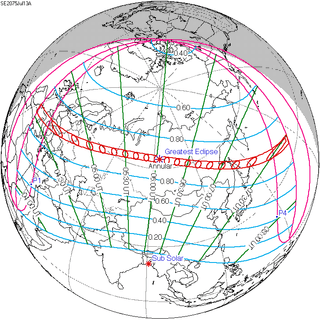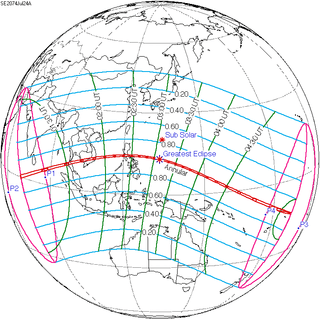Solar eclipse of July 13, 2075
| Solar eclipse of July 13, 2075 | |
|---|---|
 Map | |
| Type of eclipse | |
| Nature | Annular |
| Gamma | 0.6583 |
| Magnitude | 0.9467 |
| Maximum eclipse | |
| Duration | 285 sec (4 m 45 s) |
| Coordinates | 63°06′N 95°12′E / 63.1°N 95.2°E |
| Max. width of band | 262 km (163 mi) |
| Times (UTC) | |
| Greatest eclipse | 6:05:44 |
| References | |
| Saros | 147 (26 of 80) |
| Catalog # (SE5000) | 9676 |
An annular solar eclipse will occur on July 13, 2075. A solar eclipse occurs when the Moon passes between Earth and the Sun, thereby totally or partly obscuring the image of the Sun for a viewer on Earth. An annular solar eclipse occurs when the Moon's apparent diameter is smaller than the Sun's, blocking most of the Sun's light and causing the Sun to look like an annulus (ring). An annular eclipse appears as a partial eclipse over a region of the Earth thousands of kilometres wide.
Related eclipses
Solar eclipses 2073-2076
Each member in a semester series of solar eclipses repeats approximately every 177 days and 4 hours (a semester) at alternating nodes of the Moon's orbit.
| 122 | February 7, 2073 Partial |
127 | August 3, 2073 Total |
| 132 | January 27, 2074 Annular |
137 | July 24, 2074 Annular |
| 142 | January 16, 2075 Total |
147 | July 13, 2075 Annular |
| 152 | January 6, 2076 Total |
157 | July 1, 2076 Partial |
References
| Wikimedia Commons has media related to Solar eclipse of 2075 July 13. |
External links
- Earth visibility chart and eclipse statistics Eclipse Predictions by Fred Espenak, NASA/GSFC

